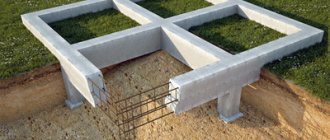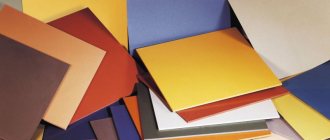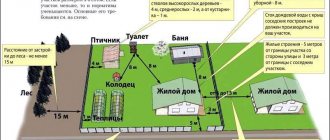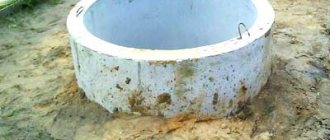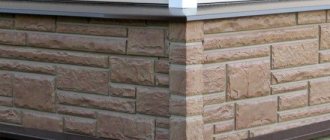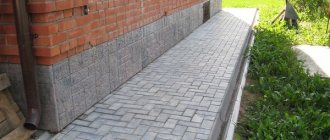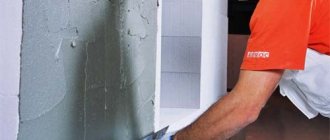Foam blocks and aerated concrete are very popular in the field of private and low-rise construction. The foam concrete block is lightweight, making it convenient for processing, transportation and installation. When plastering foam blocks is used, their service life increases. Foam concrete is characterized by high quality thermal insulation and an affordable price. The foam structure of the material allows air to pass freely. At the same time, the steam does not linger in it either. The use of foam concrete in construction allows you to create homes with a pleasant and healthy atmosphere.
To ensure the required level of vapor permeability, it is necessary to maintain the thickness of the foam block plaster layer.
Foam blocks
Foam blocks are special building blocks made from cellular concrete.
This material is well known even to non-professional builders; it has long been very popular and is used in modern construction.
Such high popularity is characterized by such indicators as:
- light weight;
- good thermal insulation properties;
- inexpensive;
- easy to install.
In order for the material to serve you for a long time, you need to know how to plaster walls made of foam blocks, because a competent external coating is the main factor of strength.
The surface of the foam blocks must be finished on the outside of the facade and on the inside of the house.
The importance of plastering blocks cannot be overestimated; if done incorrectly, as shown in the video, you can ruin all the positive characteristics of this building material.
Video:
Plastering on foam block is a very complex process, because this material has very poor adhesive properties; ordinary plasters based on cement-sand and lime do not stick to it. It is for this reason that it is better to exclude all universal plastering mixtures.
To prevent moisture from entering your room, foam blocks from cracking, and mold from appearing inside, it is necessary to properly protect the inside and outside of the walls.
For a building built from foam blocks, the most important indicator is vapor permeability; for this it is necessary to maintain the ratio of the thickness of the plaster layer from inside and outside the room.
If you are doing your own plastering and are unfamiliar with the technical aspects, then in order for your walls to remain permeable, the thickness of the inner layer should be 2 times greater than the outer one.
The layer should not be thick - 1 centimeter inside and 2 centimeters outside will be enough.
Despite the seemingly complexity of the process, not only a professional builder, but also anyone can plaster a foam block wall of a house with their own hands; you just need to read the instructions and watch the videos that we will provide.
What plaster is best for plastering aerated concrete walls?
In theory, any type of plaster is suitable for plastering aerated concrete walls, but external factors must be taken into account. Plaster for wet rooms must be resistant to moisture, for external use - to temperature changes and atmospheric influences. In potential fire zones, plaster with increased fire-resistant properties should be used, and in places adjacent to the ground or foundation - with bactericidal properties.
Plaster for indoor aerated concrete walls: cement-lime, gypsum-lime, gypsum-perlite.
Plaster for aerated concrete walls outside: cement-lime, silicate, silicone.
Types of foam concrete blocks
Foam blocks are produced by mixing cement, sand, water and a foaming agent, which can be natural or synthetic.
Foam blocks are produced using two different technologies:
- Casting technology - the finished solution is poured into a special molds where it goes through a molding and drying process. Simple production technology does not provide a perfectly smooth surface of the block; to improve adhesive properties, it is advisable to treat the surface with coarse sandpaper;
- Sawing method - a single large structure is cast from foamed concrete, which is then divided into blocks of the required size by sawing. Blocks produced using this technology have better adhesion properties and are easier to plaster.
Plastering of foam concrete walls is carried out no earlier than 28 days from the date of their manufacture. These days, there is still the possibility of cracks forming.
If you plaster blocks that have not been cured, this can negatively affect the entire process and the quality of the plaster.
Which mixture is best to use for finishing foam concrete?
When choosing plaster for leveling the internal walls of a building with your own hands, you need to focus on the adhesion of the composition; the larger it is, the better the solution is suitable for foam concrete. The most popular options for store-bought mixtures are:
- Coverplix;
- Ceresit ST24;
- Profit;
- Contact MN;
- Belsilk T-32.
To save money, some users use cement mortar for finishing block walls in the proportions of raw materials cement / lime / sand = 1: 1: 3. To improve the plasticity of the mixture, 5% chalk is added to its composition in relation to the binder and cement. This solution is much cheaper than store-bought analogues, but only experienced builders can work with it. For better fastening of the finish, a mesh is attached to the base.
Note!
Walls made of foam blocks cannot be covered with cement laitance plaster. The material will absorb a certain amount of liquid, and the second part will evaporate into the atmosphere. In the future, the solution can be wiped off the surface with your hands. This mixture also cannot be used as a primer; it will not be able to provide the necessary bonding of the base.
Solutions used for plastering foam blocks
Before finishing a foam block wall, you need to choose the right plaster, which has a wide range of characteristics:
- vapor permeability;
- elasticity;
- high adhesive properties;
- moisture resistance;
- resistance to sub-zero temperatures.
Plaster raw materials for foam blocks are produced by many construction companies producing dry mixes.
Plastering walls in houses with high levels of humidity is best done with mixtures that are resistant to moisture, made on a cement base.
Video:
External facade finishing involves the use of the same mixture. These walls should first be properly treated with moisture-repellent coatings.
Packages with dry building mixtures intended for foam concrete are marked with a special note stating that this material is suitable for use on surfaces with a porous cellular structure.
The price category of such mixtures is usually higher than that of classic finishing compositions. But if your room is made of foam concrete, you will have to not skimp on the building mixture, because only with its help you can make a high-quality coating.
Carrying out preparatory work
Using mesh for reinforcement when plastering will create a better and more even layer.
If the wall includes sawing blocks, then they do not need to provide additional roughness. At the same time, the composition produced in this way has a clear geometry, so the removal of irregularities will be minimal. The surface of the walls is first coated with a special primer. The instructions on it should contain information that the primer tends to penetrate deeply into the structure of the building material. If molded foam blocks were used in the construction of walls, then their surface should be reinforced.
All elements created by injection molding must be prepared carefully. You can go over the wall using coarse sandpaper, which will improve adhesion, and remove any remaining mortar. A reinforcement mesh made of plastic will allow you to create high-quality layers of plaster.
Important! The reinforcing mesh must be resistant to alkaline environments. If this is not provided for, then the substances contained in the mixture will destroy it over time. This may cause the plaster to peel off.
Return to contents
How to use primer coat correctly
An acrylic-based primer will interfere with the distribution of moisture, so it is better not to use it.
To apply a high-quality primer layer, you should create a primer mixture of sand and cement yourself, but rough finishing will have to take more time. After preparing the cement-sand mortar, you should coat the walls with it. The final finishing layer is applied to the plaster composition, which has not yet completely hardened on the wall.
It is not recommended to use an acrylic-based primer because it prevents the uniform distribution of moisture on the wall surface. As a result, the finished finishing layer of plaster will peel off in fragments. You can use a special service that will make an accurate calculation of the thickness of the finishing layer based on the furnishings of the room.
The rule here is simple - the outer layer of plaster should be 2 times thinner than the plaster for foam blocks inside the building. This is the only way to preserve the ability of the walls to pass air, protecting them from adverse influences from the outside.
Return to contents
Preparation for plastering
Before starting work on applying plaster, you need to make an initial leveling of the surface, repair chips and cracks.
Then a layer of primer solution must be applied to the façade of the foam concrete wall using a roller in places where this is not possible, or it can be applied using a paint brush.
To prime the facade, it is necessary to use a deep penetration solution with a high level of adhesion. Usually the primer is applied in two layers, this will make the plaster much easier to apply.
One of the main rules before applying the primer layer is to apply it to a clean and grease-free surface; if oily stains are visible on the foam blocks, they must be removed using special means.
Otherwise, the coating will fall off immediately after drying.
The facade primer should be made only with high-quality materials so that the material applied on top of it will last a long time.
Allow the primer layer to dry thoroughly and then you can proceed directly to plastering.
The need to protect walls
Walls built from foam blocks certainly need protection. In its absence, the following begins to happen.
Dust particles suspended in the air gradually settle on the outer surface of the blocks. Atmospheric precipitation also gets there. Moreover, both of them are acidic in nature.
As a result, the surface of the products, located in a slightly acidic environment, begins to gradually darken. And this greatly spoils the appearance of self-built foam concrete walls.
But this is not the most serious threat. Much more dangerous is the fact that water, penetrating into the pores of the material, ultimately ends up in the room. This, in turn, seriously worsens the indoor microclimate.
As a result, the inner surface of the walls may also suffer. Darkening may also occur on it. In some cases, the appearance of mold and fungi is observed.
Therefore, the exterior decoration of a house made of foam blocks is simply necessary. But it must be carried out with vapor-permeable materials. After all, only they will not interfere with the removal of air vapors from the premises to the outside.
Nuances of technology
Be sure to observe the temperature regime! A cold surface is not suitable, and for both external and internal finishing it is required that the walls have their own temperature not lower than +5℃, but not heated above +30℃. You should also pay attention to the absolute humidity of the surface: dry cellular concrete absorbs water almost instantly, which has a very negative effect on the drying process of the plaster layer and the correct development of strength. It is generally advisable to forcibly moisten the surface using spray bottles before applying the plaster.
It is imperative to prepare the surface for applying plaster, as mentioned above. If you are not using mesh, be sure to prime the blocks. Actually, even if there is reinforcement, a primer will not be superfluous. Before applying the primer, all dirt stains, especially oil stains, should be removed.
Additionally, pay attention to the following subtleties of the technology for plastering foam blocks:
- Reinforcing fiberglass mesh allows you to avoid cracking of the plaster at joints and in seams with an opening of more than 5 mm on old masonry. The mesh is recessed into the layer of plaster to a depth of 2/3 of its total thickness;
if the wall is uneven with vertical deviations of more than 1 cm, it is preferable to install beacons for better “pulling” in level;
finishing procedures for grouting the covering layer should be carried out only after waiting for complete drying.
Combating poor adhesion
Foam block is a rather capricious thing regarding plaster compositions. Not every sand-cement mixture mixed in a duty trough is suitable for high-quality finishing. The mass may simply fall off, especially if the vertical or horizontal deviations are large enough and it is necessary to level the surface with a thick layer of more than 5 cm.
There are two excellent, relatively inexpensive ways to increase surface adhesion (the ability to hold a plaster composition due to the mutual penetration of materials into each other).
- Coating the foam concrete surface with primers, concrete contacts and other special compounds.
Construction of reinforcing mesh. Both a special plaster mesh purchased at a construction market and a nylon fishing net with cells no larger than 5-6 cm are suitable as reinforcement.
In the absence of surface preparation using the above methods, you can follow the path of “layering” the plaster, and carry it out in three stages: spraying with a liquid layer, applying the base layer and covering. Between stages there must be enough time for the previous layer to dry completely.
Before applying plaster directly to foam concrete blocks, you must first moisten the surface. It is advisable to use a spray bottle for this in order to achieve widespread penetration of water into the cellular structure of the wall material.
